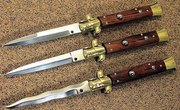
What is a Stiletto Knife?
A stiletto traditionally refers to a type of knife blade which is triangular in design rather than flat, and of above average length. While it's often referred to as a knife, a better term would be a dagger, given the parlance of the time period. The triangular cross section of the blade means that the edges would be very dull. The upside to this is that the blade would be abnormally sturdy and durable, as well as coming to a wickedly sharp point. As you may be able to guess, this makes it ideal for stabbing and is particularly adept at passing through the ribs to get at the heart or lungs of an enemy. The design was developed in Italy during the 15th century, when the art of the Vendetta, or honor duel, was an accepted and encouraged practice among the noble and wealthy. A long, thin rapier would be held in the dominant hand, and a stiletto dagger with wide cross guard would be held in the off hand. The stiletto could be used to fend off an opponent's sword or catch and trap it along the cross guard. A particularly crafty fighter might decide to wrong-foot his opponent by switching tactics during a duel, attacking with the stiletto and defending with the rapier instead.
How Do Stiletto Knives Open?
Stiletto's don't open and never have. They are a made from a single piece of solid metal from the tip of the blade to the back of the pommel. At the time they were commonly in use, openly carrying weapons on one's belt was a good way to discourage attack, and as a result, they would simply be carried in a sheath at the left hand side of the belt.
What Could Stiletto Also Refer To?

Classic Italian Stiletto Switchblades of the "Picklock" Design from the 1950s.
Many people refer to the Italian switchblade designed during the 1950s as a stiletto; however, this is not technically correct as it in no way follows the design of the original weapon. Since it is likely that many people still make this mistake, it would be impolite not to explain the workings of the Italian switchblade as well. Essentially, it is a folding knife with a straight blade and straight handle. The only innovation is the method by which the knife is opened. It's powered by a spring, rather than by hand. The base of the knife is on a hinge at the top of the handle, like all folding knives. A spring is connected off center to the base of the knife blade. When the blade is folded away, the spring is pulled and placed under tension. A button on the side of the knife is attached to a catch lever which pops in between the coils of the spring, holding the spring taut. When the button is pressed, the lever moves out of the way and the spring pulls back into its original shape, turning the blade on its hinge to extend from the front of the handle.
Writer Bio
John Albers has been a freelance writer since 2007. He's successfully published articles in the "American Psychological Association Journal" and online at Garden Guides, Title Goes Here, Mindflights Magazine and many others. He's currently expanding into creative writing and quickly gaining ground. John holds dual Bachelor of Arts degrees from the University of Central Florida in English literature and psychology.



